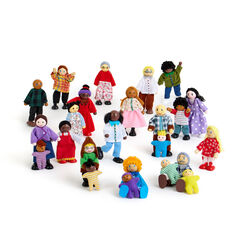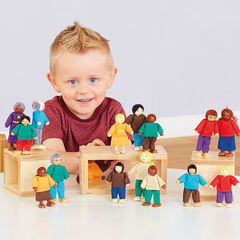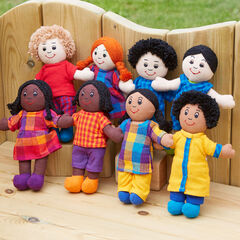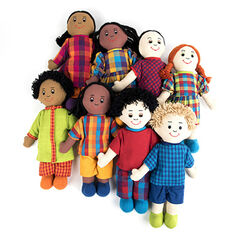In the early years of childhood, play is more than just fun – it’s a powerful way for children to explore their identities, understand the world around them, and feel seen. For many young children, dolls and small world figures become more than just toys, they can be tools for representation. They are reflections of themselves and the people they see in their lives.
In this blog, Beccie Hawes shares heart-warming and insightful stories about how we can find representation through dolls and small world figures. Beccie’s stories remind us that representation in play matters. That sometimes, the smallest figures can make the biggest impact. Over to Beccie…
It’s Chico Time!
Now this is going back a bit, but…do you remember Chico Slamani? For those of you that don’t or are too young, he was the ex-goat herder who was a quarter finalist in the 2005 series of X-Factor. Give him a Google and look out for his song: ‘It’s Chico Time!’ – a catchy novelty song. I’ll be coming back to him at the end.
I have recently been looking at many of the resources that we have in our early years settings. These are some of the questions I have been pondering on:
- Are the resources representative of the children that have access to them?
- Are they meaningful and relevant to the world in which our children live?
- Do they offer the chance for our children to explore, process and make sense of their reality?
- How do the children interact with them?
Symbolic and Imaginative Play
I often spend a lot of time marvelling at how the children use what appear to be mundane objects imaginatively to become whatever they need to develop their play and to re-enact what is relevant to them. The most common things that I see are:
- Construction blocks that become phones for the purpose of having top level gossip sessions or for delivering important and hard hitting messages.
- Semi-circular pieces of train track that transform into the steering wheels of fast cars for magical journeys to anywhere you want to go.
- Baby dolls that are dunked in a tuff tray of water and bubble bath for a serious bathing.
- Collections of random items or loose parts that are mixed and oven cooked to become Michelin star meals.
I love leaving things out for children to find and then watching how the child’s amazing mind turns them into the most magical play opportunity that helps them to connect with the world through exploring their own lived experiences.

Representation through Dolls – Meet Chico
Recently, I left the ‘Children of Our Community Cultural Diversity Dolls’ out to see what would happen. I was fully expecting them to get a full and thorough bathing. Within seconds of their discovery, a few did! Whilst helping to dry the dolls I spotted one of our quieter tiny humans walking about with one of them having a good chat. This led to a great conversation and an important pondering and reflection on representation of the children in the setting. It went something like this:
Me: Who is your new friend?
Tiny Human: This is my best friend Chico?
Me: He seems nice.
Tiny Human: He is. He is like me.
Me: How so?
Tiny Human: He has the same hair and skin as me and I’ve got some clothes like his.
Me: He looks smart.
Tiny Human: He is, like me. I’m going for some Chico time now. We’re off.
Exit tiny human and Chico for a ride in a fast car steered by a piece of semi-circular train track. For the next week the tiny human and Chico proved to be inseparable.
This made me think. For this child Chico provided a connection, a representation of the world in which he lives. He was able to see himself and this resonated deeply with him – a sense that he wasn’t alone. Perhaps we all need some Chico time! (See what I did there?) Now let’s move on to Nanny Rene!
You can Choose Your Friends but Not Your Family…or so They Say
My Nanny Rene would always tell me I was stuck with her. She meant this in the nicest of ways. She’d remind me constantly that I could choose my friends but not my family – they were a given and she certainly was here to stay. I didn’t mind, she was an incredible lady whose memories of her strong matriarchal prowess I treasure. I think she single-handedly made sure I didn’t have too many attachment difficulties as she was my significant human. A safe base from which I could explore the world.
My Family
As an adult I have ended up proving my Nanny Rene somewhat wrong (sorry nan). I now live in a blended family. Through choice and my second marriage, I am a mum to my biological son, step mum to three fantastic sons and mum to a dog and a puppy. I am blessed with a great husband. We have all chosen each other and worked hard to achieve the happy family dynamic that we have ten years after our first coming together.

The fairy tale ending of always remaining happily with the family you are born into isn’t a thing for all of our children. In today’s times the traditional 2.4 children with a mum and dad now looks very different. It takes all sorts to make a world and all sorts can make a family. To help our children explore, process and make sense of this reality, I feel that it is important that we offer the right resources to do just that. Resources that can be used for representation of the children and families in your setting. That’s where toy figures such as the Wooden Small World Diversity Multicultural Family and the Small World Representation Figures come in. They offer a valuable opportunity for children to create a family of their own and represent people, communities and cultures with a collection of wooden figures.
Who is important to you and why
The best bit for me is that the wooden figures can be anyone from anywhere – a chosen, hand-picked collection of significant or insignificant others that resonate exactly with the type of families that our children experience. That can be family in its widest sense from Mum and Mum, Dad and Mum, Dad and Dad, Nan and my Cousins, Care-Givers or the woman that lives over the road. It’s about exploring who is important to you and why. You can choose this family and play out your reality. There is no expectation of who goes with who. It’s yours – your family! This provokes so many important conversations about difference, understanding and acceptance.
Many thanks to Beccie Hawes for sharing this blog with us.
Beccie is currently proud to be the Head of Service with Cadmus Inclusive, part of Cadmus Services, which is based in Walsall. This service has a national reach and actively supports schools with all aspects of providing a high quality education for vulnerable learners. Beccie is the author of ‘The Complete Dyslexia Toolkit’ and co-author of ‘Getting it Right for SEND’ and ‘How to Create the Perfect Partnership with Parents’. Beccie also writes the national Ebriefing: SEND Bitesize. She has developed a number of educational resources to support learners which schools across the UK have purchased and use. Beccie remains very ‘hands on’ in the classroom and is passionate about being at the chalk face to support teachers and children to think differently for a brighter tomorrow. She is also the mum to four boys and two dogs.















